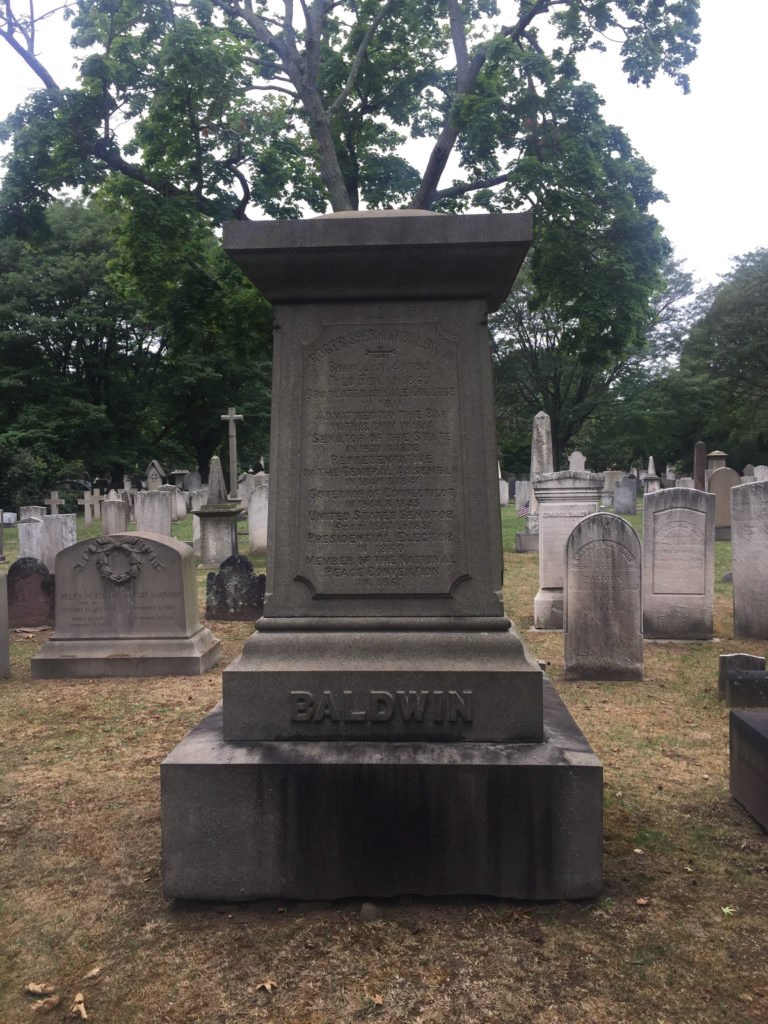Erik Visits an American Grave, Part 783
This is the grave of Roger Sherman Baldwin.

Born in 1793 in New Haven, Baldwin grew up in the Early Republic elite. His grandfather was none other than Roger Sherman, co-writer of the Declaration of Independence. He started at Yale at the age of 14, then studied law with his father and was admitted to the bar in 1814. He was a dedicated lawyer who was frequently called into politics. But it was the law that was in his heart.
Still, as a prominent Connecticut resident, he did serve more than his share of time in politics. In 1837, he was elected to the Connecticut state senate and the re-elected the next year, then to the state assembly in 1840-41 representing New Haven. There, he mostly was known for his bills to oppose slavery and fight for Black rights.
What Baldwin is particularly known for today is being one of the key lawyers in the Amistad case. He already was known for his anti-slavery positions, which sometimes elicited great anger from a public that was very much not pro-Black, even in the north. Abolitionists, led by Lewis Tappan, were willing to spend the money it took to provide the self-freed slaves the best defense money could buy. So they chose Baldwin and John Quincy Adams for the job. Obviously, everyone already knew Adams. Baldwin was more obscure outside of legal circles but this made him famous. In the case before the Supreme Court, Baldwin handled the arguments concerning the basic right that all people had to liberty, with Adams using his skills to finish the job and convince the Court to free the Africans. Matthew McConaughey played Baldwin in the Spielberg film, which I find amusing for some reason.
The state legislature of Connecticut chose the nominees at this time and so the Whigs chose Baldwin in 1844 for a one-year term and then sent him back in 1845. He won both elections by a narrow margin over the Democratic nominee. As governor, his focus was primarily on internal improvements (a true Whig) with the national atmosphere focused on the annexation of Texas and the unjust war against Mexico. He also did a ton of work on educational reform, creating a statewide education committee to standardize the school year and the quality of teachers, which varied tremendously from town to town. He also pushed for legislation to reduce laws limiting the amount of property foreign-born people could hold, which was certainly not a unifying position for Whigs given they dominated the anti-Irish sentiment that would lead to the Know-Nothing Party a few years later. He also pushed for election reform, primarily voter registration, to limit voter fraud, which unlike today, was actually a real issue in the 1840s.
Finally, Baldwin pushed for the official end of slavery in Connecticut, which while the institution was basically moot at this point, was not officially abolished until 1848. The state had created a system of gradual emancipation all the way back in 1784. But there adults that were still slaves in that state until 1857, when a woman named Nancy Toney died. Baldwin was not able to sign this legislation, but he laid the groundwork. Overall though, Baldwin had a shaky relationship with the legislature and after he vetoed a bill that would have forced a company that had built a toll bridge to fix it themselves. But the legislature overrode the veto and did not renominate him in 1846.
In 1847, Senator Jabez Huntington died. Baldwin received the appointment to replace him. He served the rest of his term, which ended at the beginning of 1851. He doesn’t seem to have played a major role during his short tenure there with one exception, which was his strong opposition to slavery and especially the Fugitive Slave Act. But Whigs did not choose to send him back when his term expired.
After he left the Senate, Baldwin went back to the law for the rest of his life. The one exception is that he attended the peace convention in early 1861 that attempted to avert the Civil War, but of course that went absolutely nowhere because Abraham Lincoln was unwilling to cower to southern bullying. He had supported Lincoln in 1860 as well. He died in 1863, at the age of 70.
Roger Sherman Baldwin is buried in Grove Street Cemetery, New Haven, Connecticut.
If you would like this series to visit other senators who served with Baldwin, you can donate to cover the required expenses here. James Whitcomb who is in Indianapolis and James Shields is in Carrollton, Missouri. Previous posts in this series are archived here.


